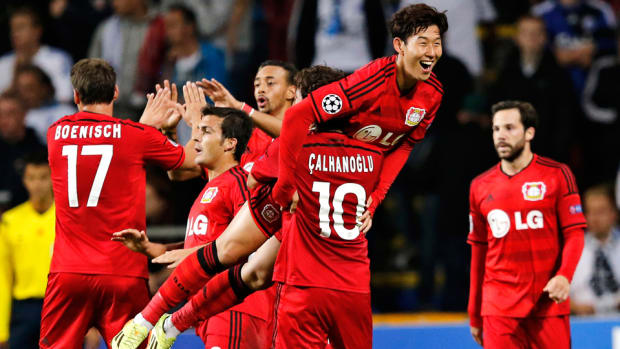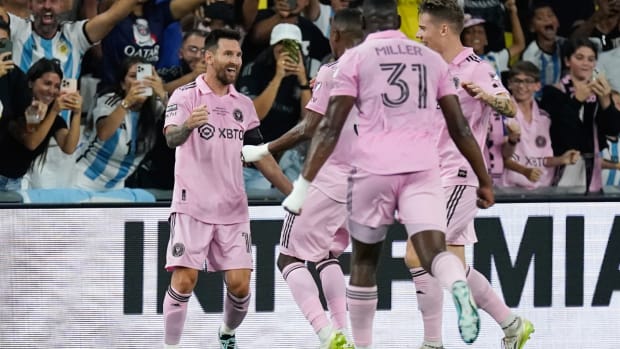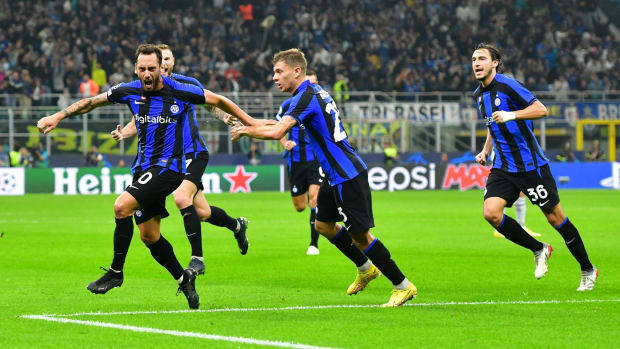Even when there was next to no traction, there was tradition.
Back when American soccer was many miles from the mainstream and when the World Cup may as well have been staged on Mars, the U.S. men and Mexico were playing for passage to the tournament.
Technically, the first qualifier between the neighbors (and first meeting, period) was in far-off Rome, just three days before the start of the 1934 World Cup proper. The U.S. traveled by boat. The Americans then triumphed thanks to four goals from future Pittsburgh Steelers and Cleveland Rams coach Aldo ‘Buff’ Donelli, earning the right to get blasted, 7–1, by the host Italians shortly thereafter. Around 10,000 fans attended that inaugural U.S.-Mexico match at the old Stadio Nazionale, according to reports. Among them was dictator Benito Mussolini.
The qualifying rivalry continued after World War II, although in reality it wasn’t much of one. Mexico dominated proceedings for four decades as the U.S. wandered and flailed in the World Cup wilderness and, at times, appeared to turn its back on the sport for good. But the games (and losses) persisted, cycle after quadrennial cycle. And when it was the U.S. Soccer Federation’s turn to host it typically preferred venues in Southern California, where the crowd probably was even less supportive than it had been in fascist Rome.
That history will feel a lot more like myth on Friday night in Cincinnati, where the U.S., now ranked 13th in the world, will host No. 9 Mexico at TQL Stadium—a state-of-the-art, six-month-old facility built only for soccer. It sold out for this 2022 World Cup qualifier in about an hour, and its 26,000 seats will be filled almost entirely by enthusiastic, partisan U.S. fans hailing from all 50 states and the nation’s capital. That’s by design. U.S. Soccer steers tickets toward established, registered groups of members and supporters in order to generate the atmosphere and home-field advantage it never enjoyed during soccer’s long American dark age.
The U.S.-Mexico rivalry—there’s still not a consensus on a catchy English-language nickname—now includes frequent matchups in the Concacaf Gold Cup, the regional championship tournament that’s been claimed 15 out of 16 times by one of the two North American powers. And there have been meetings at other international events as well, including the new Nations League and the World Cup itself, along with routine friendlies.
But none has the feel of a modern home qualifier. It’s not just about the months of build-up and anticipation (unlike a quick turnaround at a tournament). It’s about controlling the rules of engagement. Every four years, the U.S. gets to meet Mexico on its own turf and terms. Gold Cup, Nations League and Copa América games are organized by governing bodies seeking to maximize revenue, not atmosphere. That means large, “neutral” venues and mostly pro-Mexico crowds.
But the qualifier—that presents an opportunity to create and celebrate a patriotic setting unlike anything else in American sports. It’s the one and only U.S.-Mexico match where the conditions are tilted in the Americans’ favor. For whatever parity has been achieved on the pitch over the past three decades—the U.S. holds a 19-14-12 overall advantage since the “modern era” began in 1990—Mexico still loves the game more. Soccer has a far greater hold on day-to-day life south of the border. But that’s irrelevant once every four years. On that night—on Friday—the U.S. looms large. That’s when it looks and feels like a tried, true and traditional soccer nation.
“It’s home turf. That’s what it’s about in those events,” says U.S. coach Gregg Berhalter, who faced El Tri in numerous settings and competitions as a player (including the victory at the 2002 World Cup) before coaching against them in four large, pro-Mexico stadiums on American soil.
“For us, it’s the one time that you play them where you know you’re on home turf and everyone’s behind you, and that’s an amazing feeling,” Berhalter continues. “Just thinking about the [qualifiers] we played against them here, particularly in Columbus, the atmosphere and the excitement in the stands just makes it for us, as players and coaches, a really special event.”
It was in nearby Columbus, the site of Major League Soccer’s first soccer-specific stadium, that the qualifiers and the rivalry took on new life. Across five games and four consecutive victories, the U.S. finally established some sort of home-field advantage over its longtime tormenter. With that came indelible milestones, memories and bits of lore. “Dos A Cero” and "La Guerra Fría” are now part of the American soccer lexicon. And most U.S. fans can easily picture Oguchi Onyewu’s 2005 staredown of Jared Borgetti or the 2013 qualifying clincher punctuated by Landon Donovan’s final international goal, not to mention the pre-match photo of two rivals standing united days after the divisive 2016 presidential election. It all helped lay the foundation for an authentic American soccer culture while building a lot of American soccer belief.
“It’s an opportunity for us to kind of showcase what we’re doing here,” says midfielder Kellyn Acosta, one of four men on the current U.S. squad with U.S.-Mexico qualifying experience. “Obviously the three points are huge, but it’s more so building [our] confidence and showing the world and everyone the U.S. is here and we’re a top team.”
And so the home qualifier became the biggest domestic, non-neutral event in the sport. It’s U.S. Soccer’s Super Bowl. Media credential requests are almost double the average for the three previous home qualifiers contested this fall, and four TV networks will be on site in Cincinnati.
“This is a breakthrough showcase moment for the sport and specifically for U.S. Soccer. And when I say ‘breakthrough,’ every sports network is talking about it. It breaks into lifestyle. We have people who may not be from the sport tune in. We’ve got all of our corporate partners here. It’s a game that’s circled on the calendar,” says U.S. Soccer chief commercial officer David Wright.
“The content and the storylines and the lead-up to this game is unlike any other game that we have on the calendar. So to me, it’s much bigger than how many people are going to be at the stadium.”
It all sounds like something that U.S. Soccer, TV networks, sponsors and national team fans might want to protect fiercely. The same should go for Mexico and its interest in bringing the U.S. to the Azteca every four years. There’s nothing like a trip to soccer’s Death Star, where from an American perspective, mere survival makes you a legend. The 10-man draw in 1997 and Michael Bradley’s outrageous, long-range chip 20 years later are as much a part of the historic fabric as anything that’s happened in Ohio.
That’s the beauty of a true home-and-home. It creates a colorful context for the sort of memories that bring a sport to life. For three decades, the U.S.-Mexico World Cup qualifiers have provided the pulsating rhythm to a rivalry that was once so one-sided and lifeless.
All of this matters more than ever this week because following Friday’s game and then March’s return engagement in Mexico City, the rivalry is almost surely going to lose a large chunk of that partisan pulse. Change is on the horizon, and all indications are that these upcoming games could very well be the last World Cup qualifiers between the pair. Both will advance automatically to the 2026 tournament co-hosted by the U.S., Canada, and Mexico. They won’t play any qualifiers at all. After that, the World Cup’s expansion from 32 teams to an unwieldy 48, plus the potential increased frequency proposed by FIFA, will require a streamlined qualifying procedure that likely will be designed to keep the regional heavyweights apart.
True home games organized by U.S. Soccer or the Mexican federation will still be possible, of course. But they’ll be friendlies, or part of some kind of new manufactured North American competition. The days and decades of playing in a wholly supportive or hostile environment—with a spot in the biggest event in sports at stake—appear to be ending. And so an era does as well.
“It’s been mentioned to me by a number of people and I’ve had a chance to reflect on it. It’s something that adds another special element to this already special game,” Berhalter says. “There’s going to be times when we play them that there’s going to be a lot on the line. There’s Nations League. It doesn’t seem like that’s going away. There’s Gold Cup. There’s other formats, potentially, where we get to play them. We just won’t have the big ticket on the line—the World Cup.”
The reasons are complex and hinge on the World Cup’s size, the competitive balance in Concacaf and the evolving proposals to overhaul FIFA’s international calendar (which governs the global club and country schedule). None of it looks good for the future of a U.S.-Mexico World Cup qualifying series that’s comprised 29 games across 88 years.
By the time the 2026 World Cup concludes in Los Angeles, New York or wherever FIFA decides to play the final (it’s touring potential stadiums this fall), global football will look different. Although FIFA has backed off ramming through its impractical plan for a biennial World Cup thanks to fierce opposition from powerful members in Europe and South America—next month’s vote has evolved into just a “global summit”—there’s broader agreement on the need to reconfigure the calendar. The current framework, which expires at the end of 2024, typically requires clubs to make players available for five two-game national team windows per year, plus a summer tournament (with some exceptions).
Even those interested in maintaining the traditional quadrennial World Cup see the wisdom in potentially reducing the number of windows, especially considering the long-haul travel demanded for so many players. FIFA’s original plan was radical: one lengthy, seven-game international window each October-November. That would essentially kill national team soccer, however, robbing players and coaches of the opportunity to develop much continuity or chemistry. In addition, individual countries will have little interest in reducing the number of games they control and market. Many of those 10 annual international matches are World Cup qualifiers. And so compromises are under discussion.
“I would like to see FIFA calendar reform,” says Berhalter, who coached club soccer in Sweden and MLS before taking the U.S. job in late 2018. “I’d like for them to go look at it and see what makes the most sense for the players. I think it should be in the best interest of the player and the participants. We also want to have excitement for soccer. We want to continue to drive fan engagement. But I think there’s other ways to do it. I don’t know if it necessarily means a World Cup every two years.
“But there certainly needs to be calendar reform, where we look at what the players are doing and give them the necessary time off and minimize travel,” he concludes.
One of the ideas Berhalter references, and which has been circulating among executives at higher levels, is the reintroduction of a secondary global national team tournament. FIFA hastily canceled the Confederations Cup (an eight-nation event featuring six continental champs, the reigning World Cup winner and next World Cup host) after the 2017 edition as it pursued another one of its extravagant ambitions, a 24-team Club World Cup.
That tournament never materialized, however, meaning FIFA just clumsily yielded that space in the calendar. The Confederations Cup was a fun and mostly harmless event that gave national teams—especially those outside Europe—a valuable extra opportunity to test themselves against unfamiliar opposition. Something new or similar based on continental championships like the Gold Cup—or even events like the Nations League—now seems more likely than a biennial World Cup.
But however those compromises shake out, one key change already is certain. From 2026, World Cups will have 48 teams, including at least six from Concacaf (a playoff place or two will be up for grabs as well). That’s double the allotment, and to get a sense of how much that’ll test the region’s depth, consider that only five of Concacaf’s 41 eligible members have advanced to more than one World Cup. Since the U.S. turned the corner in 1990, only seven have qualified at all. At the moment, the sixth highest-ranked Concacaf team is El Salvador, which is 65th in the world. Concacaf is a top-heavy region, and there’s no appetite within or without for a World Cup qualifying format that involves the U.S. and Mexico obliterating island minnows.
The traditional six-team, home-and-home Hexagonal, which produced those memorable U.S.-Mexico clashes from the 1998 cycle through 2018, is pointless when all six participants would qualify. The Octagonal, used this time as a response to the pandemic, also won’t work. Nobody’s going to want to sit through 56 games just to eliminate one side (six automatic spots plus a playoff), and there’s no plan to employ this format again. So what about a 10- or 12-team group? It might be impossible with the reduction of international dates or windows, not to mention impractical considering the disparity in strength among confederation members. Concacaf qualifying will almost certainly have to get more efficient—even more so if the World Cup eventually takes place every two years.
One of Concacaf’s primary recent missions has been to offer its smaller countries more opportunities to play meaningful games. That’s what the Nations League has been about, and it was one of the inspirations behind the current World Cup format designed to give each team a minimum of four qualifiers. Once you offer something, it’s tough to take it back. So any future qualifying format likely will include more games for smaller teams, meaning less time for the bigger ones to play everybody.
So with no large, single final-round grouping feasible or desirable, there’s little choice but to have more than one. The top three from each of two groups could advance to the World Cup, for example, or the top two finishers from three. No such format anywhere in the world would seed the top two teams into the same round-robin group. Unless there’s a sea change in the rankings, or unless Concacaf just tosses competitive integrity aside, it seems unlikely that the U.S. and Mexico would intersect on the road to future World Cups.
"I can imagine that they’ll seed teams,” Berhalter says. “You have a preliminary round, and then maybe start a round where you get to groups of four. And then from there, the top places go [to the World Cup] and then the second-place [teams] playoff for the next two spots.”
Like everyone else, Concacaf is waiting to see how FIFA’s calendar revisions shake out. In a statement provided to Sports Illustrated, the confederation reiterated its desire to “provide all Concacaf federations with a chance to compete to qualify for the biggest stage in world football.”
In other words, its priority is building the sport throughout the region, not preserving U.S.-Mexico games it doesn’t market or control.
It added, “In terms of future qualification formats for FIFA World Cups, a FIFA-led process to agree a new international men’s calendar post 2024 is currently underway. When that is concluded, Concacaf will work to develop a structure for qualification of teams to the FIFA World Cup 2026, which will be the first 48-team World Cup and will be a hugely exciting prospect for football in the region as it will be hosted in Canada, Mexico and the USA.”
In other words, the 48-team World Cup will change everything.
Wright said that U.S. Soccer has plenty to be excited about, even in the absence of qualifiers against Mexico.
“We’re at the beginning of a 10-year run unlike any 10-year run in the history of soccer in this country,” he says.
The federation is negotiating a new TV deal that’ll start in 2023, and it has the ’26 World Cup on the horizon. There will be an Olympic tournament in Los Angeles in ’28, and the U.S. intends to bid for either the ’27 or ’31 Women’s World Cup. U.S. Soccer’s technical and marketing staffs also are already planning for the competitive build-up to 2026, which should include multiple friendlies against high-profile nations hoping to visit and get the lay of the land, Wright says.
Meanwhile, Concacaf intends to launch the second edition of the Nations League next year, and there are Gold Cups already planned for the summer of ’23 and ’25. U.S.-Mexico games in those competitions won’t have the same feel as a home qualifier, but they’ll ensure the rivalry remains part of the routine. Perhaps a challenge trophy, similar to the ones created for college football rivalries, could be created. The idea has been floated, and Berhalter says he’d be happy to take his squad back to the Azteca at some point down the road.
“Our mission is to make soccer the preeminent sport in this country and a game like the U.S.-Mexico game [this] week is a piece to that much larger puzzle. But it’s not the only piece. So we have to look at this with a long-term tail,” Wright says.
The rivalry obviously is too deeply embedded into the sporting culture of both nations to wither. Soccer is growing in the U.S. It’s already preeminent in Mexico, and the blending and friction between the countries as they compete for trophies, dual-national players and fans will keep the pulse rate high enough to matter. But it won’t be the same after Friday, or after qualifying concludes in the spring. The games that helped forge and cement one of soccer’s richest and most storied rivalries are ending. But in a way, they served their purpose. Tradition has created traction.
“I don’t think the rivalry is going to lose anything. I just think we’re going to miss these games. Our fans are going to miss these games. As players and coaches, we’re going to miss the games,” Berhalter says.
“But the rivalry will always be there as far as I can see, because it’s two teams that are desperately fighting for the same thing,” he continues. “We both want to be recognized as top teams in the world. We both want to be recognized as leaders in our region and the best team in our region. Something has to give when you have those elements together.”
Read more of SI's Daily Cover stories here:
• Straus: A Young USMNT Learns to Embrace Concacaf's Dark Arts
• Hornby: How the Failed Super League Exacerbated the Fan-Owner Dynamic
• Straus: Joe Biden's Many Intersections With The Beautiful Game
• Straus: The Unexpected Rise of Another U.S. Teen Abroad













